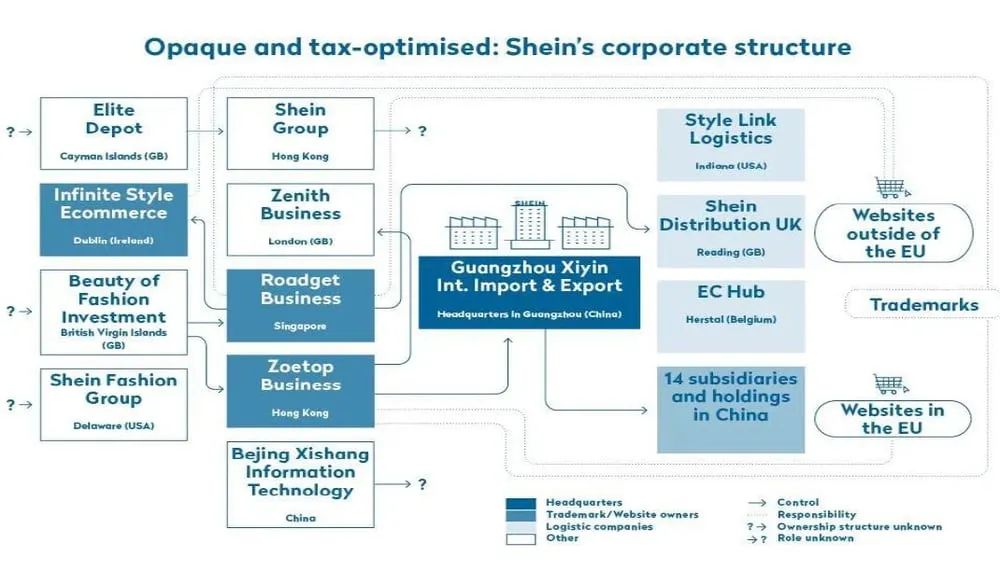This summer, three independent designers filed a lawsuit against Shein in a federal court in California, accusing the fast fashion company of copying their work and selling it. They alleged that Shein has infringed on their copyrights and therefore violated the Racketeer Influenced and Corrupt Organizations (RICO) Act in the US.
While lawsuits involving Shein aren’t entirely uncommon, what’s intriguing about this case is a further claim made by the designers. They alleged that Shein possesses a “secret” algorithm that manipulates market data and search results, unfairly and monopolistically driving competitors out of the market.
Specifically, the plaintiffs claimed that products made with the assistance of this algorithm would significantly harm the careers of independent designers, and that the artificial intelligence Shein is purportedly using is smart enough to pirate the most commercially viable works.


Shein’s RICO lawsuit sounds alarm for responsible AI
The significance of this case is indeed noteworthy not just for its David versus Goliath nature, but also because it offers valuable insights into how courts may approach AI regulation in the future. The outcomes of this RICO lawsuit could potentially influence ethical considerations related to AI technology.
For example, the plaintiffs argued that Shein’s algorithm generates false or misleading information, including product popularity, customer reviews, and pricing trends. Additionally, by inflating performance metrics and suppressing negative feedback artificially, users may be misled regarding the desirability and quality of products.
Such manipulation of market data can have severe consequences, causing consumers to make purchasing decisions based on inaccurate or biased information. This not only damages consumer trust but also disrupts competitive dynamics, giving Shein an unfair advantage.
To mitigate the potential risks and challenges of applying AI technology, some experts believe it’s necessary to establish regulations for responsible AI use. By integrating responsible AI practices, companies can proactively minimize the risk of falling into legal disputes. Actions that companies can take in light of cases like the Shein lawsuit include:
- Governance: Companies’ boards should consider establishing governance bodies to ensure responsible AI adoption aligns with their values and culture.
- Policy: Implement policies for responsible AI usage, encompassing mechanisms to mitigate legal, technical, and financial risks, and define ethical boundaries based on the company’s values.
- Training: Provide training to employees according to their roles in the company’s AI initiatives. For example, legal and technical teams should receive training on legal and technical risks related to AI use, as well as ethics and financial risks.
- Contracting: When relying on third-party service providers to deploy AI solutions, establish robust contract standards to mitigate potential claims risks and supplier liability. Due diligence is crucial when selecting providers.
- Ethics: Although not mandatory, it’s important to ensure all AI use complies with the company’s policies and regulations. In addition, consider establishing an independent AI ethics review committee.
- Conduct: Leading companies might consider adopting industry-recognized codes of conduct, including obtaining approval from regulatory authorities when applicable.
- Compliance: Boards should ensure adequate resources are allocated to ensure compliance with intervention measures and address violations of company policies.
Shein’s RICO lawsuit serves as a warning for businesses. By adhering to ethical frameworks and regulations, implementing robust data governance, continuous testing and monitoring, and fostering collaboration and accountability, companies can reduce the risk of legal disputes related to AI technology, particularly in the absence of regulations.
Breaking the mold with AI in design, production, and sales
In the past few years, Shein has rapidly become one of, if not the largest fast fashion company in the world. Key to its meteoric rise has been its ability to produce clothing quickly and inexpensively, selling products at incredibly low prices.
An important factor is Shein’s utilization of AI technology to identify fashion trends at scale, enabling it to mass produce thousands of clothing items within a short time frame, giving fast fashion a whole new meaning.
According to Vox, analysts have called Shein’s business model “real-time retail” because it can create new designs in as little as three days. BBC also reported that Shein’s website lists as many as 600,000 items at any given time.
To enhance design efficiency, Shein has developed a smart design support system, turning design into an assembly line process. By analyzing data of fashion trends, Shein’s design team can quickly produce design samples using this system.
In addition to predicting fashion trends, Shein also uses AI to provide precise recommendations. By analyzing user history, browsing behavior, and interests, Shein can provide personalized product recommendations for each user, improving the shopping experience, increasing sales, and customer loyalty.
Furthermore, Shein employs AI for its customer service functions. Using natural language processing (NLP) and chatbots, Shein can quickly respond to user inquiries and provide accurate answers and suggestions. This not only enhances customer satisfaction but also reduces the workload of its customer service personnel.
Currently, Shein’s business covers over 220 countries and regions globally, making efficient logistics and delivery a key challenge for its further expansion. To address this, Shein utilizes AI for intelligent warehousing and distribution. By analyzing order data and warehouse inventory, Shein can automate warehouse management and schedule delivery vehicles, enhancing the efficiency and accuracy of its logistics operations.
By applying AI technology in various aspects, Shein has enhanced its operational efficiency and user experience across its entire value chain, from design to production and sales. In other words, Shein isn’t just a traditional e-commerce platform—it’s a new-generation e-commerce company driven primarily by AI.
Deciphering Shein’s business model
In May this year, Shein raised USD 2 billion in its latest round of financing, valuing the company at USD 66 billion. This funding round was jointly led by Sequoia Capital, Atlantic Investments, and the Mubadala Investment Company, which is Abu Dhabi’s sovereign wealth fund.
The massive scale of Shein today threatens to overshadow its relatively humble beginnings. Founded as early as 2008, the company only started to embark on a rapid growth trajectory in 2015. Its revenue reached around USD 610 million in 2016, USD 1.55 billion in 2017, USD 1.99 billion in 2018, and approximately USD 3.15 billion in 2019.
Despite the upheaval of the 2020 pandemic, its revenue rocketed to USD 9.81 billion, experiencing exponential growth. The figure reached USD 15.7 billion the following year, before hitting a new high by achieving USD 22.7 billion in revenue in 2022. To put this in perspective, its annual revenue in 2022 is around 20% of Alibaba (USD 116.8 billion) and nearly 130% of Pinduoduo (USD 17.8 billion). According to insiders with knowledge of the matter, Shein has set a target of 40% revenue growth for this year.
Shein’s explosive growth can be attributed to several “secret” factors.
Like Xiaomi’s Lei Jun, Shein understands the art of speed
Shein pioneered the “small orders, fast returns” model, meaning it tests the market with an initial, small order quantity. When consumer-side data indicates that a product is a “potential hit,” the company increases production orders for that item at the factory.
Unlike traditional order-based production, this agile model greatly reduces inventory and shifts the fundamental logic of the entire supply chain.
The key to operating a fast fashion company is to rapidly introduce a large number of new products while controlling unsold inventory. Currently, Shein’s unsold inventory rate is only 10%, ostensibly half of that of global fast fashion brand Zara (15%).
AI business analysts have suggested that Shein’s approach aligns with Xiaomi CEO Lei Jun’s Chinese seven-word mantra that emphasizes four key factors: focus, perfection, reputation, and speed. Trust and efficiency underline these factors.
According to Lei Jun, an efficient company can provide better products and services and by extension, offer more value, making it more trustable to customers. Therefore, businesses should aspire to use every means possible to understand the needs of users, obtain feedback as quickly as possible, and make updates and improvements at the earliest opportunity.
Managing B2B suppliers like a B2C company
Traditional clothing manufacturers often favor working with large, stable suppliers. In contrast, Shein often partners with smaller suppliers, at times colloquially referred to as “workshop factories.” This preference primarily stems from the inability of large factories to meet the demands of its “small orders, fast returns” model. Relying on a handful of large factories, as opposed to multiple smaller ones, also carries significant risks.
Nonetheless, managing smaller-sized suppliers can present its own set of challenges. To address these issues, Shein built a “cloud factory” platform which is essentially a digitized supply chain system, utilizing platform-based bidding to collaborate with its suppliers.
Shein has also enlisted the services of hundreds of fabric and accessory suppliers, creating an online B2B supplier platform. This platform not only streamlines the onboarding process for suppliers, making it convenient for them to purchase materials and accessories, but it also offers professional procurement guidance tailored to specific clothing designs.
Furthermore, Shein’s cloud factory platform operates on an order-based model when interacting with suppliers. Shein formulates its order requirements based on real-time sales data derived from its website and mobile app, subsequently releasing them on the platform. Suppliers can directly accept these orders on the platform, a process akin to the bidding model utilized by Meituan for its delivery services and Uber for its ride-hailing services.

Shein has gone all-in on digital marketing
With the prevalence of social media marketing and live streaming, Shein has increasingly emphasized three critical areas: social media platforms, influencers, and its recommendation algorithm.
Shein has not only established accounts on major overseas platforms such as Facebook, Twitter, Instagram, Pinterest, and TikTok but has also created over 80 secondary accounts tailored to different regional markets, specific clothing product types, and target customer groups. This forms an account matrix in which the main account drives traffic to the secondary accounts. Each secondary account caters to a specific target audience, enabling differentiation in marketing strategies.
To encourage users to consistently visit the Shein website and mobile app, the company has introduced various user engagement games and a point-based system. Users accumulate points for regular logins, game participation, content sharing, and participation in discussions. These points can be directly used to redeem discounts when purchasing products from Shein, with 100 points equivalent to around one US dollar.
What can Shein teach us about AI?
With both B2B and B2C companies facing reduced budgets in today’s challenging economic environment, it’s not surprising that AI has been seen as a kind of holy grail, seemingly poised to unlock new and lucrative revenue streams.
However, up to this point, there have been no standout AI products that have made a significant impact. Despite the introduction of large models over the past year, which have gained widespread popularity, it remains uncertain how they can be effectively harnessed to generate revenue and achieve profitability. This might be attributed to AI being a largely academic field, with founders having academic backgrounds typically displaying weaker business and product development capabilities.
Moreover, the costs associated with R&D in this field are substantial, putting financial pressure on AI startups and companies, and their high burn rates make them vulnerable to financial challenges in the absence of a breakthrough.
As valuations and market capitalizations continue to shrink, layoffs inevitably become the norm. The industry is grappling with its challenges, and the outlook seems worrisome, with the global economy under immense pressure and the China-US trade situation remaining severe for the time being.
China’s economy cannot unilaterally resolve these issues; it requires a new growth engine that taps into the potential of companies on a global scale. Many are placing their hopes on innovative tech companies, perhaps believing that innovations like large models will eventually come to fruition in the right hands, achieving profitability and unlocking new opportunities.
Shein presents a strong case for this perspective. While its lawsuit may be controversial, its success underscores a fact: when AI is applied appropriately, it can unexpectedly play a powerful role as a catalyst for commercialization and monetization.
By having a deep understanding of the business landscape and knowing how to judiciously apply AI to business scenarios, companies can discover innovative ways to create value.
This article was adapted based on a feature originally written by and published on AI Biz Week (WeChat ID: aibizweek). KrASIA is authorized to translate, adapt, and publish its contents.

